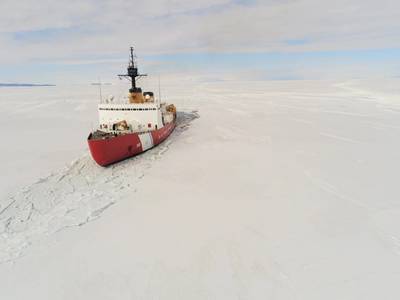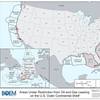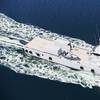US, Canada, Finland Launch Effort to Build Icebreaking Ships
The U.S., Canada and Finland will form a consortium to build icebreaker ships, a senior U.S. administration official said, a move intended to bolster the allies' shipbuilding and counter Russia and China in increasingly strategic polar regions.
The initiative, called the Icebreaker Collaboration Effort or ICE pact, is being unveiled on Thursday on the sidelines of a three-day NATO summit in Washington, where the alliance has called on China to end its support for Moscow's war against Ukraine.
The pact aims to produce a fleet of ice-breaking ships to "project power" into the polar regions and enforce international norms and treaties, a senior U.S. administration official told reporters, calling it a "strategic imperative."
The deal - which the three NATO members aim to sign by year-end - will pool demand from allies to scale shipbuilding capacity, the official said, adding that it was designed to send a message to Russia and China.
"Without this arrangement, we'd risk our adversaries developing an advantage in a specialized technology with vast geostrategic importance, which could also allow them to become the preferred supplier for countries that also have an interest in purchasing polar icebreakers," the official said.
U.S. lawmakers and experts have lamented the atrophy of U.S. shipbuilding capacity in recent years, especially because China is producing naval ships at unprecedented levels.
Construction of U.S. Navy ships is years behind schedule.
The official did not give a timeline for the new icebreakers nor say how many vessels the U.S. sought to produce under the pact, but noted the U.S. currently only has two icebreakers, which both are nearing the end of their lifespan.
"We intend to scale up by multiples of the current amount as soon as we can," the official said.
Together, the governments will identify shipyards in the three countries that can meet demand from partners and allies.
"Right now, it's too small, and it's taking too long, and we're not generating the production that we need," the official said. The official said U.S. allies want 70 to 90 icebreakers over the next decade.
The move comes as China seeks to develop new shipping routes in the Arctic and expand its research in Antarctica. Western governments worry China's army could gain better operational and surveillance capabilities from its polar activities.
As climate change shrinks polar ice packs, Arctic seas are increasingly being used as trade routes connecting the Pacific and Atlantic oceans to major economies.
China and Russia have been working together to develop Arctic shipping routes as Russia seeks to deliver more oil and gas to China while Moscow is under increased Western sanctions.
Russia has more than 40 icebreakers with more in production, and China operates its own smaller but growing fleet. The two countries signed a "no limits" partnership days before Russia's 2022 invasion of Ukraine.
Canada and Finland combined have dozens of icebreakers.
(Reuters - Reporting by Michael Martina; Editing by Don Durfee and Cynthia Osterman)














